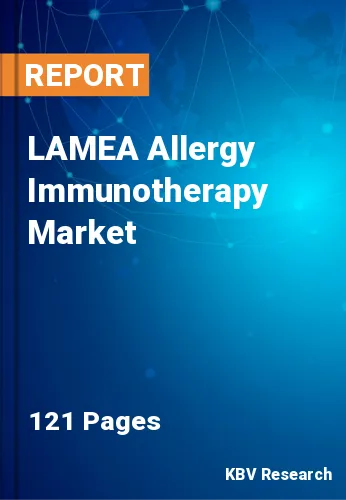The Latin America, Middle East and Africa Allergy Immunotherapy Market would witness market growth of 12.9% CAGR during the forecast period (2023-2030).
Due to the rising incidence of allergies and the desire for efficient treatment alternatives, the market is predicted to rise steadily throughout this time. The development of alternative immunotherapeutic medications, such as oral drops, sublingual tablets, and other types of allergy immunotherapy, may further aid in the market's expansion. The market is anticipated to grow significantly throughout this time due to the introduction of new goods and technology. Market expansion is anticipated due to the development of cutting-edge immunotherapy therapies such as immunoglobulin E (IgE) inhibitors, biologics, and gene therapies.
The market will have significant long-term growth possibilities in the future due to the rising need for individualized and successful allergy treatments from patients, doctors, and healthcare systems. Additionally, the growing need for personalized healthcare and precision medicine will probably spur the creation of novel immunotherapy treatments customized to the needs of each patient. The main factors driving the market are the rising prevalence of different types of allergies and the introduction of innovative sublingual immunotherapies in emerging nations. The increasing prevalence of various types of allergies is one of the key factors driving the market.
Large portions of the Middle East are desert. While the summer months might be hot and humid, the winter months can see considerable drops in temperature. These climatic fluctuations have the potential to aggravate chronic respiratory disorders in sensitive patients, notably asthmatics. The Asthma Program of the Department of Health seeks to reduce visits to emergency rooms, hospitalizations, absences from work and school, and, most significantly, asthma-related fatalities. The rising asthma cases and the continues working towards its treatment will surge the usage of medicine like bronchodilators and hence boost the market growth.
The Brazil market dominated the LAMEA Allergy Immunotherapy Market by Country in 2022, and would continue to be a dominant market till 2030; thereby, achieving a market value of $57.8 million by 2030. The Argentina market is anticipated to grow at a CAGR of 13.5% during (2023 - 2030). Additionally, The UAE market would exhibit a CAGR of 12.6% during (2023 - 2030).
Based on Distribution Channel, the market is segmented into Retail Pharmacy, Hospital Pharmacy, and Online Pharmacy. Based on Treatment Type, the market is segmented into Subcutaneous Immunotherapy (SCIT), and Sublingual Immunotherapy (SLIT) (Tablets, and Drops). Based on Allergy Type, the market is segmented into Allergic Rhinitis, Allergic Asthma, and Others. Based on countries, the market is segmented into Brazil, Argentina, UAE, Saudi Arabia, South Africa, Nigeria, and Rest of LAMEA.
Free Valuable Insights: The Worldwide Allergy Immunotherapy Market is Projected to reach USD 2.9 Billion by 2030, at a CAGR of 8.4%
The market research report covers the analysis of key stake holders of the market. Key companies profiled in the report include Viatris, Inc. (Mylan N.V.), Merck KGaA , NIOX Group plc , DMS Imaging SA, Adamis Pharmaceuticals Corporation, Stallergenes Greer International AG (B-Flexion), Allergy Therapeutics plc , DBV Technologies S.A., HAL Allergy B.V. (Droege International Group AG.), LETI Pharma, S.L.U.
By Distribution Channel
By Treatment Type
By Allergy Type
By Country
Our team of dedicated experts can provide you with attractive expansion opportunities for your business.

